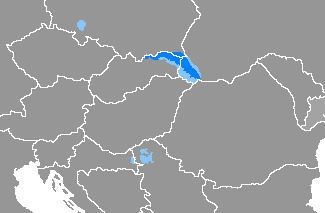Pronunciation /ˈruːsɨn/ ISO 639-3 rue | Ethnicity Rusyns | |
 | ||
Native speakers 62,000 (2000–2006)
Census population: 70,000. These are numbers from national official bureaus for statistics:
Slovakia – 33,482
Serbia – 15,626
Ukraine – 6,725
Poland – 10,000
Croatia – 2,337
Hungary – 1,113
Czech Republic – 777 Language family Indo-European
Balto-Slavic
Slavic
East Slavic
Rusyn Recognised minority
language in Czech Republic
Serbia
Slovakia
Ukraine | ||
Rusyn /ˈruːsᵻn/ (Rusyn: русиньска бесїда, rusin'ska besyida, or русиньскый язык, rusin'skıy yazık), also known in English as Ruthene /rʊˈθiːn/ /ruːˈθiːn/ (sometimes Ruthenian), is an Eastern Slavic language spoken by the Rusyns of Eastern Europe and historically in parts of Central Europe.
Contents
- Geographical distribution
- Classification
- Grammars and codification
- Dialects
- Alphabet
- Newspapers
- References
There are controversial political implications about the nature of Rusyn as a language or dialect. Some linguists treat it as a distinct language (with its own ISO 639-3 code), whereas some Ukrainian scholars of Slavic languages treat it as a dialect of Ukrainian.
Geographical distribution
Rusyn, or, specifically, Carpatho-Rusyn, is a vernacular spoken in the Transcarpathian Region of Ukraine; northeastern Slovakia; in Vojvodina, Serbia; southeastern Poland, where the Rusyn dialect is generally known as Łemkowski, after the characteristic word лем/lem (meaning "only", "but" and "like"); Hungary (where the people and language are called Ruszin); and northern Maramureș, Romania, where the people are called Ruteni and the language Ruteană.
Classification
The classification and identification of the Rusyn language is historically and politically problematic. Before World War I, Rusyns were recognized as the Ukrainians of Galicia within the Austro-Hungarian Empire. Crown Prince Franz Ferdinand had planned to recognize them as one of the ten states of a planned United States of Greater Austria before his assassination. After the war, Austria-Hungary was partitioned, and Carpathian Ukraine was appended to the new Czechoslovak state as its easternmost province. With the advent of World War II, Carpathian Ukraine declared its independence, lasting one day, until its annexation by Hungary. After the war, the Ukrainian Carpathians of Czechoslovakia, occupied by Hungary, were annexed by the Soviet Union as part of the Ukrainian SSR, which proceeded with an anti-ethnic assimilation program. Poland did the same, using internal exile to move all Rusyns from the southern homelands to western areas conquered from Germany, and immersed in Polish.
Scholars with the former Institute of Slavic and Balkan Studies in Moscow (now the Institute of Slavonic Studies of the Russian Academy of Sciences) formally re-acknowledged Rusyn as a separate language in 1992, and trained specialists to study the language. These studies were financially supported by the Russian Academy of Sciences.
Ukrainian politicians do not recognise Rusyns as a separate ethnicity, regardless of Rusyn self-identification. Ukraine officially considers Rusyn a dialect of Ukrainian, related to the Hutsul dialect of Ukrainian.
Attempts to standardise variants of Rusyn have been unsuccessful. Rusyns live in four countries, and efforts are hampered because Rusyns living outside the traditional home region often do not speak the language fluently. Different orthographies have been developed (in most cases using variants of the Cyrillic script), and a number of different grammatical standards exist, based on regional dialects.
It is not possible to estimate accurately the number of fluent speakers of Rusyn; however, their number is estimated in the tens of thousands, primarily living in Ukraine and Slovakia.
Serbia has recognized Rusyn, more precisely Pannonian Rusyn in Vojvodina, Serbia as an official minority language. Since 1995, Rusyn has been recognized as a minority language in Slovakia, enjoying the status of an official language in municipalities where more than 20 percent of the inhabitants speak Rusyn.
Rusyn is listed as a protected language by the European Charter for Regional or Minority Languages in Slovakia, Serbia, Croatia and Romania.
Grammars and codification
The Rusyn dialect was codified as a language in Vojvodina region of Yugoslavia in 1923 and in Slovakia in 1995. Early grammars include Dmytrij Vyslockij's (Дмитрий Вислоцкий) Карпаторусский букварь (Karpatorusskij bukvar') Vanja Hunjanky (1931) and Metodyj Trochanovskij's Буквар. Перша книжечка для народных школ. (Bukvar. Perša knyžečka dlja narodnıx škol.) (1935).
Dialects
The Carpatho-Rusyn language can be divided as follows:
Boiko, Hutsul, Lemko and Dolynian Rusyn are (most often) identified as Ukrainian dialects since most of their speakers identify themselves as Ukrainians (or in the case of the Lemkos of Poland, only as Lemkos).
Alphabet
Until World War II, the letter Ѣ ѣ (їть) was used, and was pronounced /ji/ or /i/.
